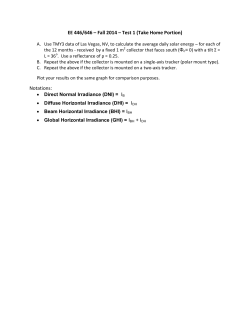
Small Guide to Making Nice Tables Markus Püschel Carnegie Mellon University www.ece.cmu.edu/~pueschel
Small Guide to Making Nice Tables
Markus Püschel
Carnegie Mellon University
www.ece.cmu.edu/~pueschel
Which One Looks Better?
Easy decision, isn’t it?
Another One
If your tables tend to look like the above
you may find this guide helpful
Background
Up to 2005, I had been writing technical publications for 8
years, creating roughly 35 fully reviewed papers, 2 theses,
20 proposals, and many other pages of technical writing
In each case I spent a lot of effort on content and visual
presentation; I am really picky
In 2005 I learned (from Goran Frehse, thank you!) that I
had had no clue how to make tables
I summarize what I have learned in this short guide
Resources
“Chicago Manual of Style,” The University of Chicago
Press
Latex users: Use booktabs.sty and its documentation
http://texcatalogue.sarovar.org/entries/booktabs.html
Most Important Guidelines for Making Tables
Avoid vertical lines
Avoid “boxing up” cells, usually 3 horizontal lines are
enough: above, below, and after heading (see examples in
this guide)
Avoid double horizontal lines
Enough space between rows
If in doubt, align left
Example: Before and After
Before:
also the first column
gets a header
everything left aligned
three horizontal lines only,
I like the top and bottom ones bolder
After:
more space between rows
space to the left edge removed
space to the right edge removed
In Latex
Style: \usepackage{booktabs}
Horizontal lines: read documentation of booktabs
http://texcatalogue.sarovar.org/entries/booktabs.html
More space between rows:
\renewcommand{\arraystretch}{1.2} (or 1.3)
Remove space to the vertical edges:
\begin{tabular}{@{}lll@{}} …
Hierarchical Tables: Examples
One level of hierarchy:
x-axis only
One level of hierarchy:
x-axis and y-axis
Latex Example
Table from the bottom of the previous slide:
\usepackage{booktabs}
\newcommand{\ra}[1]{\renewcommand{\arraystretch}{#1}}
\begin{table*}\centering
\ra{1.3}
\begin{tabular}{@{}rrrrcrrrcrrr@{}}\toprule
& \multicolumn{3}{c}{$w = 8$} & \phantom{abc}& \multicolumn{3}{c}{$w = 16$} &
\phantom{abc} & \multicolumn{3}{c}{$w = 32$}\\
\cmidrule{2-4} \cmidrule{6-8} \cmidrule{10-12}
& $t=0$ & $t=1$ & $t=2$ && $t=0$ & $t=1$ & $t=2$ && $t=0$ & $t=1$ & $t=2$\\ \midrule
$dir=1$\\
$c$ & 0.0790 & 0.1692 & 0.2945 && 0.3670 & 0.7187 & 3.1815 && -1.0032 & -1.7104 & -21.7969\\
$c$ & -0.8651& 50.0476& 5.9384&& -9.0714& 297.0923& 46.2143&& 4.3590& 34.5809& 76.9167\\
$c$ & 124.2756& -50.9612& -14.2721&& 128.2265& -630.5455& -381.0930&& -121.0518& -137.1210& -220.2500\\
$dir=0$\\
$c$ & 0.0357& 1.2473& 0.2119&& 0.3593& -0.2755& 2.1764&& -1.2998& -3.8202& -1.2784\\
$c$ & -17.9048& -37.1111& 8.8591&& -30.7381& -9.5952& -3.0000&& -11.1631& -5.7108& -15.6728\\
$c$ & 105.5518& 232.1160& -94.7351&& 100.2497& 141.2778& -259.7326&& 52.5745& 10.1098& -140.2130\\
\bottomrule
\end{tabular}
\caption{Caption}
\end{table*}
Further Examples
The following tables are taken from the magazine
Economist
They demonstrate
How to handle multiple levels of hierarchy
Alignment, handling of long headers
The use of light gray to further divide the tables
Horizontal lines provide readability under denser packing and
when lots of numbers are organized
Sans serif fonts are preferrable for readability;
of course, if you need math symbols and use latex, then stick with
roman
Title above table, sometimes with unit of measure
The use of footnotes
Different types of horizontal lines
(I personally don’t like the use of more than two)
Example Tables I
Example Tables II
Example Tables III
Example Tables IV
Example Tables V
© Copyright 2025





















